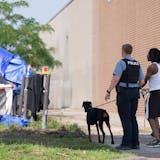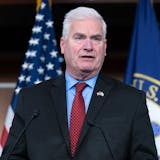On Monday morning, contract workers began snipping razor wire and removing it from fencing that was propped atop concrete barriers along the perimeter of Minneapolis’ former Third Precinct police station, which was set ablaze during the uprising over George Floyd’s police killing 4½ years ago.
Eventually, the concrete barricades and construction fencing will be erected closer to the building. As private security guards looked on Monday, contractors began removing the security measures put in place to secure the building at 3000 Minnehaha Av. that became a target of protests.
For the past three years, Third Precinct police officers have been based out of a city building in downtown Minneapolis, with plans to eventually bring them back to a south Minneapolis Community Safety Center just down the street at 2633 Minnehaha Av.
What to do with the former police station — home to what has been called a “playground” for renegade cops — has been the subject of heated debate, with the Minneapolis City Council and Mayor Jacob Frey at odds.
While the city debated its future, some conservatives jumped at the chance to use the charred building as a backdrop to hold news conferences and news reports in which they blasted the city and its leaders. Most recently, vice presidential nominee JD Vance made a campaign stop in front of the building earlier this month to blast his opponent, Gov. Tim Walz, for his handling of the 2020 riots and portray Minneapolis as a city overrun with crime.
After that, several council members expressed frustration at the city’s failure to clean up the site. Despite signs saying “cleanup efforts are underway,” concrete barriers, fencing and razor wire remained all summer.
Council Member Aurin Chowdhury said earlier this month that the blight makes people feel uncared for and gives opportunists a backdrop to manipulate the scene for political gain.
Council Member Linea Palmisano blamed some of her council colleagues for the delays, accusing some members of being “desperate for any objection” to Frey’s proposal. The council passed a resolution saying that the building should not be used for any law enforcement functions again. Palmisano called it disgraceful that the building remains, scarred and secured, over four years later.



